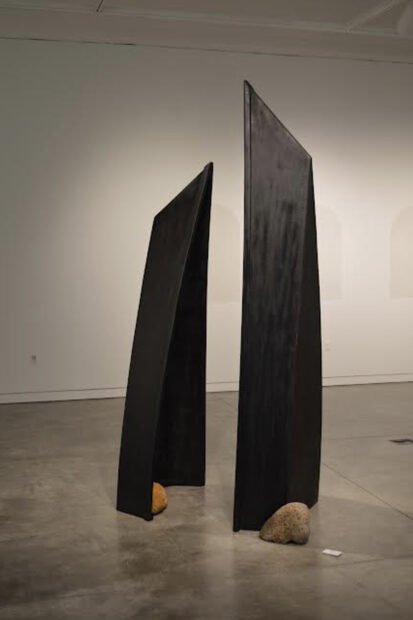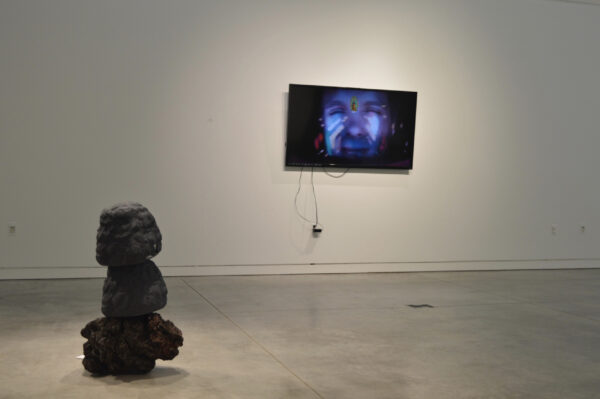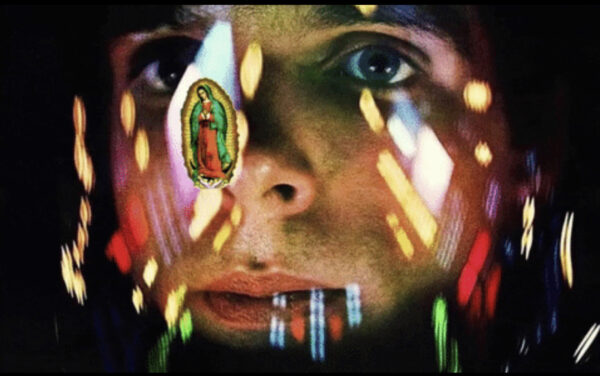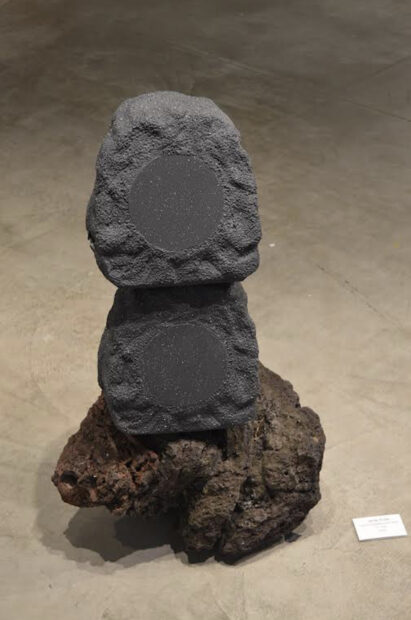Para leer este artículo en español, por favor vaya aquí. To read this article in Spanish, please go here.

Hector Ramirez, “¼ Canoe, ¾ Canoe,” 2022, wood, rock, 99 x 43 x 31 inches. Image courtesy of the artist.
Hector Ramirez is a Fort Worth-based artist. His sculptural assemblages, videos, GIFs, paintings and experimental works relate with humor and poignancy to moments from his past, observations of the present, and thoughtful reflections on his hometown of El Paso, Texas. His work pairs nuanced considerations of borderland identities and Mexican-American culture with iconic references to science fiction, religion, and domestic life.
Ramirez has exhibited extensively throughout the DFW metroplex, including a summer 2022 solo show, Colonias Plasticas, at Brookhaven College in Farmers Branch. Having followed Ramirez’s work for years, I wanted to learn more about his playful approach to making and how he navigates the space between criticality and tender sentiment. We sat down to talk about it in late August.
Billi London-Gray (BLG): To get started, what would you say your art is about?
Hector Ramirez (HR): If I had to put it in words on the spot, I think I would say it’s my perspective on things, whatever is happening or whatever I’m thinking about.
BLG: What do you usually think about or pay attention to?
HR: I see a lot of things, like references to back to home and borderland identity. It’s weird, because when I go to El Paso, I know I’m from there and that’s home, but I’ve also started seeing things from a broader perspective now, kind of from the outside. Things that happen in my neighborhood, or family things, are themes that I go back to, get inspired by, and get ideas from.
BLG: Are you an outlier? Is most of your family still in El Paso and close together?
HR: Yeah, I think it’s just me and a cousin of mine who’s in the Bay Area.
BLG: For me, I feel like my perspective is different from the rest of my family because I’m regarded as the person who left and went away. Is it like that?
HR: I don’t know if in my family it’s like that. I guess what happens is that I end up missing a lot of the stuff that I didn’t take advantage of when I was in El Paso. I’m over here and I’m missing all that stuff, and so when I get there, I’m seeking it. But then I realize I’m so different now that sometimes it feels like, “Oh, this is not for me anymore.” But then sometimes it’s like, “Oh, this is interesting, there’s definitely something here.”

Hector Ramirez, “Choir Stone,” 2022, plastic speaker, lava rock, looped sound, 31 x 20 x 20 inches. Image courtesy of the artist.
BLG: It seems like that’s also a type of borderland, like you’re crossing back and forth over a metaphorical frontier as an insider/outsider.
HR: Yeah, it’s part of the identity. It’s interesting, growing up in a border town, sometimes you feel like it is its own little place or its own little country. I feel that way sometimes in El Paso. It’s not quite Mexico, and it’s not quite the United States or not quite Texas. There’s something unique that I like about it.
BLG: Are there certain motifs, visually or with materials, that you revisit related to borderlands?
HR: Definitely. Drywall texture is one of those things, and references to religious iconographies, especially the Virgin Mary or the Virgen de Guadalupe. Also sci-fi, like imagery from 2001: A Space Odyssey. I go to those, and lately I kind of mix them. I realized there’s similarities between 2001’s monolith and the Virgen de Guadalupe.
BLG: The video, Lupe 2001, in your recent show at Brookhaven, looks like it’s really calling on those last two things.
HR: Yeah, I want this feeling of sci-fi but also questioning or searching for something. I see these parallels. For example, [in 2001], the monolith appears and kind of becomes this tool for awakening civilization, and I see that, too, with the story of the Virgin Mary appearing to Juan Diego. A little bit of, “Whoa, there’s salvation here.” I’m referencing the history and stories I grew up with, that mythology of the Virgen de Guadalupe. I’ll probably get in trouble saying it’s like a myth.
BLG: I think on the flip side of that, people sometimes canonize science fiction as a guiding mythology. It’s similar to the way people use religious stories or religious texts as the metaphor that allows them to frame their experience and understand them. I think science fiction also helps people make sense of things.
HR: Watching 2001 as a kid, I thought, “Oh, this makes sense, how humans evolved.” It made an impact and a connection for me. We’d watch this movie with my dad so he could put us to sleep when we were little.
BLG: He’d put you to sleep to 2001?
HR: Yeah, because after the scene where the monkeys go crazy and then all of a sudden you’re in space, you do that flip, it’s like super slow, the music, the orchestra. As a kid it just knocked me out. It wasn’t until I was probably in my early twenties when I finished that movie. As a kid I always fell asleep. It was a bedtime movie.
BLG: That’s awesome.
HR: I always go back to those things. It’s personal — my personal history and questions that I have. I’m questioning, “Where does religion fall in all this, if we go to space, if it’s the future?” But also, being raised Catholic, I still sometimes feel like, “Oh, man, am I doing something bad? Are we questioning too much, and something bad is gonna happen to us?” That’s how I play with those connections.
BLG: I think it’s interesting to bring up the idea of questioning too much, opening Pandora’s Box. Because I think that’s one of the things the arts do. The arts go and touch the forbidden things and try to make the sacred profane or switch roles around. Society needs that. You need artists to be the people who will go touch the untouchable and allow everybody else to go, too. But there’s certainly that question of how far is too far.
HR: Yeah, like is it a good idea to go colonize Mars? It’s kind of exciting but also very scary, and I don’t know if it’s a good thing. Let’s look at history, right? The Virgen de Guadalupe is kind of a product of that, like a second conquest by the Spanish. It was a way of spiritually conquering.
BLG: The spiritual conquering is the second conquest, after physically conquering people and land?
HR: Yes. The Virgen de Guadalupe, you know, she’s brown-skinned, she looks more indigenous, she has the tilma, she’s on this half-moon. I don’t know if I’m right or wrong, but I always felt like there’s some references to indigenous culture. There’s a male god and a female god, a Mother Nature. The [second conquest strategy] is, “Let’s talk about this mother of Jesus or mother of God, so we can have other people believe and follow our ways.” There are all these questions that I have with conquering. Are we doing the same thing? Is colonizing Mars a good idea? Is God watching us? Or is it just ranting?
BLG: These are important questions!
I want to ask more about your materials, because you use a lot of non-traditional art materials. I love your piece Carpet Shoes, a pair of worn leather shoes with carpet attached to the soles. The work is cheeky and poignant at the same time, leaving a track while potentially erasing a track, but in that way erasing the trace of a person, too. I’m wondering what draws you to materials? And how much chance is involved, or do you go out searching for certain kinds of things?
HR: It’s a little bit of both. As cheesy as it sounds, sometimes it’s a gut feeling. I have tons of stuff that I’m just holding onto. Sometimes I’m attracted to formal qualities. Sometimes it’s also that there’s symbolism or something heavier there that I like. I enjoy collecting and then arranging and collaging things. Some musicians will just drop a bunch of words into a box and then just pick things out, and whatever matches, they build off. I think Bob Dylan did that a lot.
BLG: And it’s also a Dada strategy.
HR: Yeah. I kind of start off that way, where I start with one thing that I’m obsessed with or thinking about, and then I start thinking about what other things could go with it. I like the process of building from one idea to another through connections. Within that, there’s wittiness or mischievousness, being a good jokester, but also recognizing not everything is going to be funny. Sometimes in my head, my intent is, “This is going to be funny,” and then it ends up being super sweet or tender. It changes. I try to connect as much as possible, but I also just try to be honest. I’m not going to change the world. I’m just this dude in Fort Worth who’s doing this weird thing, right? We’re all doing this weird thing if we really look at it. Everybody’s doing something different, but we’re all a bunch of weirdos. My friends and family back home, they can’t believe how much money I spend on stupid things I just look at on OfferUp or Craigslist. Or that I go dumpster diving when I see something cool or something calls my attention and I’m like, “Oh, that’s interesting!”
BLG: Would you ever display your collections as an insight to your creative process?
HR: I don’t know. I think I would start getting obsessed that there were no connections. For me, the ideas are interesting and fun, and then I get obsessed with the connections that are happening. Like the things with the Virgin Mary, sci-fi, and 2001. These kind of started as a joke or being a bad boy: “Here’s making fun of this Virgin Mary culture.” But I was not trying to make fun of people who believe, I was just making these funny connections. I was also just playing, figuring out that I could make things on GIF apps, and collecting screenshots.

Hector Ramirez, “Lupe 2001,” 2022, looping digital video, 51 x 34 inches (dimensions vary by display). Image courtesy of the artist.
BLG: I value collecting. When you’re talking about how it starts — as one thing but ends up another — I can relate. I collect whiskers from the floor when they fall out of my cats, cicada wings from the street, and cedar waxwing feathers from the ground. I keep them in a tiny tackle box. It started as a silly experiment. It was something Kid Billi would have done, and I wanted to bring Kid Billi back, because Kid Billi didn’t worry like Adult Billi. But it’s sweet and special to me now.
HR: Yeah, you definitely have to kind of think that way. For me, a lot of the time it’s like, “Oh, I used to play with this,” or “Oh, I remember so-and-so had this,” or “My grandfather had this.” I’m just connecting things to my personal history and building from there. I play around and joke a little bit. Sometimes having a friend around while I’m working helps because I get a laugh and know I’m on the right track.
BLG: Speaking of playing with other artists, you’ll be in a group show coming up at The Pool for Fall Gallery Night on September 10 in Fort Worth. What will be involved in that?
HR: It’s a new thing. It’s a big group show. I think the idea is to have objects installed, but not formally. The curators are also playful, and that got me interested. This is kind of risky, but it could also go really, hilariously well. This is down my alley.
BLG: There’s going to be some figuring out for the audience?
HR: I think so.
Hector Ramirez contributed to NOW KITH, a group exhibition curated by Kickpigeon Kids (Max Marshall and Cosmo Jones) at The Pool in Fort Worth, which opened September 10 and runs through October 2. The Pool was open noon to 9 pm for Fort Worth’s Fall Gallery Night on Saturday, September 10. The venue, located at 1801 8th Avenue in Fort Worth, will otherwise be open Saturday and Sunday from noon to 6 pm during the exhibition. For additional information on the exhibition, go here.




1 comment
Nice work and words